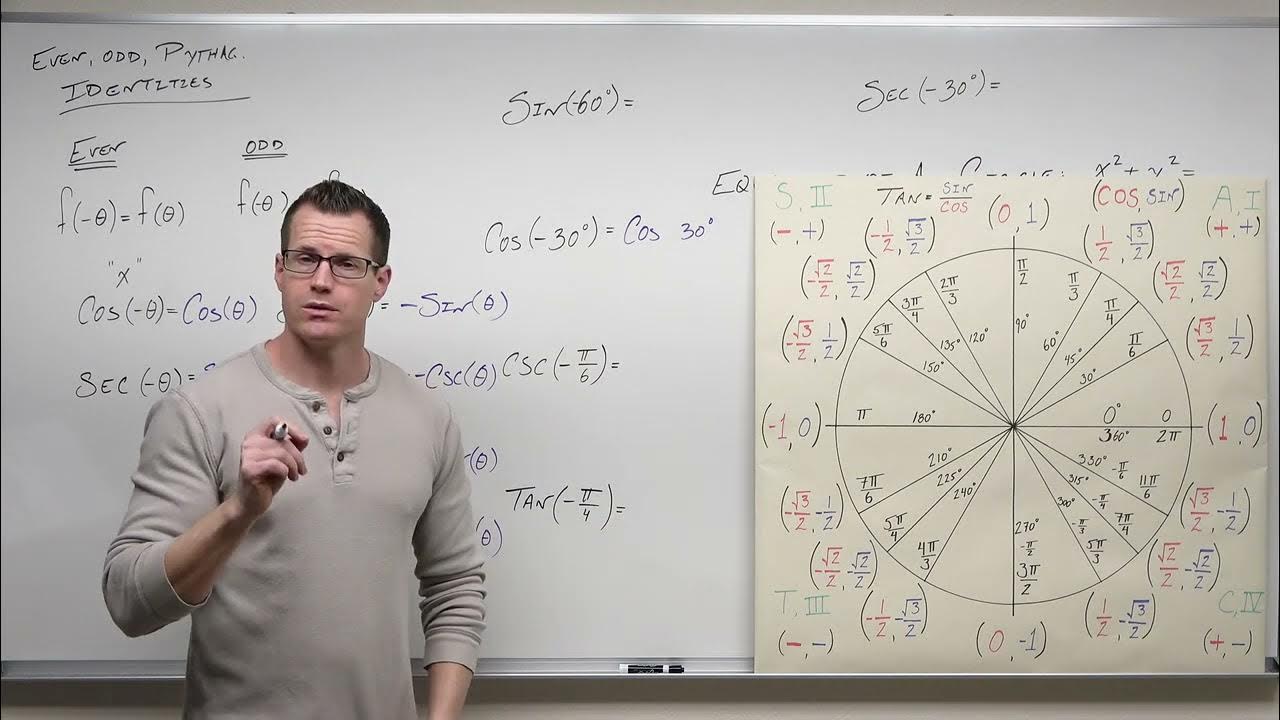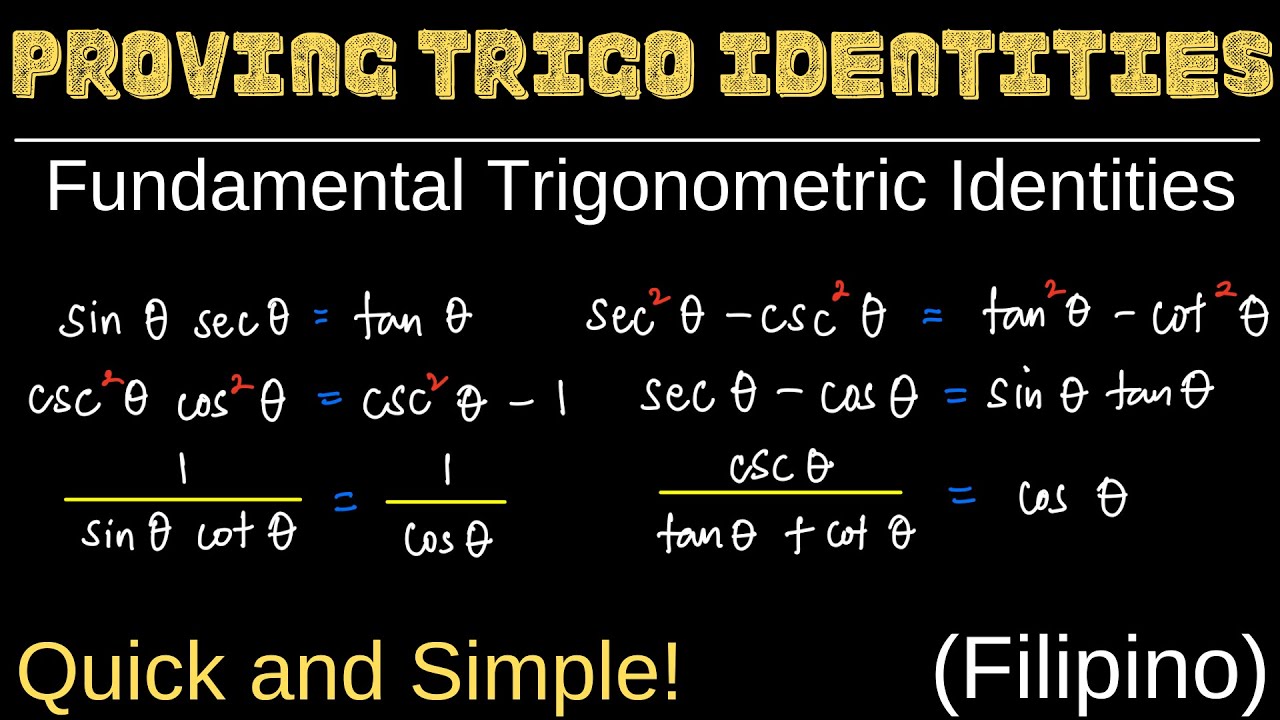Introduction to Using Trigonometric Identities (Precalculus - Trigonometry 23)
TLDRThis video script introduces the concept of trigonometric identities, emphasizing their importance for simplifying complex mathematical problems, particularly in calculus. The speaker outlines basic identities, including reciprocal, Pythagorean, and even-odd identities, and provides a step-by-step approach to simplifying trigonometric expressions. The process involves starting with the more complex side of an equation, combining fractions with a common denominator, and converting all functions into sines and cosines whenever possible. The script also highlights the necessity of using known identities and avoiding unnecessary complications. By simplifying trigonometric functions, students can more efficiently handle challenging mathematical problems, a skill that becomes increasingly valuable as they progress in their studies.
Takeaways
- 📚 Start by understanding basic trigonometric identities, which are crucial for simplifying expressions and proving more complex identities.
- 🔄 Know the reciprocal identities, such as tangent being sine over cosine, and the Pythagorean identities like sine squared plus cosine squared equals one.
- ↔️ Recognize that identities are two-way streets; if one form is true, so is its reciprocal, which is essential for simplifying and proving identities.
- ➗ When dealing with multiple fractions, aim to combine them into a single fraction with a common denominator.
- 🔢 Use the Pythagorean identities in various forms, such as tan squared plus one equals secant squared, to manipulate and simplify trigonometric expressions.
- 🤔 Begin simplifying or proving an identity by starting with the more complex side, which often involves writing everything in terms of sines and cosines.
- ✅ Always use known identities and avoid making up your own, as they are well-established and will lead to correct simplifications.
- 🚫 Avoid crossing out terms that are not multiplied together, as this can lead to incorrect simplifications.
- 🔁 Look for opportunities to factor expressions, especially when everything is in terms of a single trigonometric function like cosine.
- 📉 Simplify expressions by canceling out common terms in the numerator and denominator, which can significantly reduce the complexity.
- 🔀 Remember that even and odd functions behave differently with respect to negative angles, which affects how identities are applied.
- ➡️ The thought process for simplifying or proving identities involves combining fractions, writing in terms of sines and cosines, and using known identities to reach the simplest form.
Q & A
What is the main topic of the video?
-The main topic of the video is trigonometric identities, focusing on their importance, how to use them, and how they can simplify mathematical processes.
Why are trigonometric identities considered useful in calculus?
-Trigonometric identities are considered useful in calculus because they can simplify complex expressions and make dealing with trigonometric functions easier, especially when proving more advanced mathematical concepts.
What are the basic types of trigonometric identities mentioned in the video?
-The basic types of trigonometric identities mentioned in the video are reciprocal identities, Pythagorean identities, and even-odd identities.
How can one use the Pythagorean identities to simplify trigonometric expressions?
-One can use the Pythagorean identities to simplify trigonometric expressions by manipulating the relationships between sine and cosine squared, such as recognizing that sine squared theta plus cosine squared theta equals one.
What is the significance of even and odd identities in trigonometry?
-Even and odd identities in trigonometry are significant because they determine how the function behaves with respect to negative angles. Even functions like cosine and secant yield the same result for both positive and negative angles, while odd functions like sine and tangent yield results that are negatives of each other.
What is the first step suggested in the video for simplifying trigonometric expressions?
-The first step suggested in the video for simplifying trigonometric expressions is to start with the more complex side and use known identities to simplify the expression.
How can one combine multiple fractions in a trigonometric expression?
-One can combine multiple fractions in a trigonometric expression by finding a common denominator, which allows the fractions to be added or subtracted more easily.
What is the purpose of writing everything in terms of sines and cosines when simplifying trigonometric identities?
-Writing everything in terms of sines and cosines simplifies the process because these functions have well-known relationships and identities, making it easier to recognize and apply simplification techniques.
Why is it important to recognize that trigonometric identities are two-way streets?
-It is important to recognize that trigonometric identities are two-way streets because it means that the relationships can be used in both directions, allowing for greater flexibility and efficiency in solving and simplifying trigonometric expressions.
What is the final step suggested in the video for simplifying a trigonometric expression?
-The final step suggested in the video for simplifying a trigonometric expression is to use known identities to write the expression in the most concise form possible, without overcomplicating or expanding it unnecessarily.
What is the advice given in the video for approaching a problem that seems to be getting more complex instead of simpler?
-The advice given in the video for approaching a problem that seems to be getting more complex is to stop and reassess the approach. If the problem is 'exploding' and not simplifying, it might be a sign that a different method or identity should be used.
Outlines
😀 Introduction to Trigonometric Identities
This paragraph introduces the topic of trigonometric identities and emphasizes their importance in simplifying mathematical problems, especially in calculus. It discusses the basic identities, including reciprocal, Pythagorean, and even-odd identities, and suggests memorizing them for easier application in complex problems. The paragraph also outlines a thought process for simplifying trigonometric expressions using these identities.
🔍 Simplifying Trigonometric Expressions
The second paragraph delves into the process of simplifying trigonometric expressions. It advises starting with the more complex side of an equation and combining fractions with a common denominator. The paragraph also stresses the importance of converting all functions into sines and cosines and using known identities to simplify the expressions. An example is given to illustrate the process, highlighting the cancellation of terms and the use of reciprocal identities.
📚 Common Denominators and Factoring
This paragraph focuses on the technique of finding a common denominator for fractions and the importance of factoring in simplifying trigonometric expressions. It warns against the common mistake of incorrectly combining terms and emphasizes the need to distribute terms correctly when combining fractions. The paragraph also demonstrates how to combine terms over a common denominator and simplify using known identities, such as the Pythagorean identity.
🚫 Avoiding Overcomplication
The fourth paragraph cautions against overcomplicating the simplification process. It advises using known identities and not creating new ones. The paragraph also discusses the possibility of simplifying expressions by factoring, especially when all terms are in cosine form. An example is provided to show how factoring can lead to a more concise form of the expression, avoiding unnecessary complexity.
🔄 Recap and Future Topics
The final paragraph recaps the strategies for simplifying trigonometric identities, including using the more complex side, writing everything in terms of sines and cosines, and factoring when possible. It also teases the next video, which will cover more advanced identities and proofs, promising a step-by-step guide with many examples.
Mindmap
Keywords
💡Trigonometric Identities
💡Even and Odd Functions
💡Pythagorean Identities
💡Reciprocal Identities
💡Simplification
💡Common Denominator
💡Factoring
💡Sine and Cosine Functions
💡Secant and Cosecant Functions
💡Tangent and Cotangent Functions
💡Algebraic Techniques
Highlights
Introduction to trigonometric identities and their importance in simplifying mathematical problems.
Explanation of basic trigonometric identities, including reciprocal, Pythagorean, and even-odd identities.
The significance of understanding identities for tackling more complex problems in calculus.
Strategy for simplifying trigonometric expressions by combining fractions and using known identities.
Demonstration of converting tangent and cosecant into sines and cosines for simplification.
Use of the Pythagorean identity to simplify expressions involving sine and cosine squared.
Technique for changing everything into sines and cosines when stuck on an identity.
Emphasis on the two-way nature of identities and their flexible application in problem-solving.
Approach to simplifying complex fractions by finding a common denominator.
The process of factoring as a method to simplify trigonometric expressions, especially when everything is in terms of cosine.
Warning against overcomplicating problems by incorrectly applying identities or algebraic maneuvers.
Example of simplifying an expression involving sine and cosine by factoring and using identities.
Advice on when to stop and reassess if a problem is becoming overly complex instead of simplifying.
The importance of recognizing when an expression is already simplified and not overmanipulating it.
Strategy for simplifying by writing everything in terms of sines and cosines and then applying factoring techniques.
Final recap of the steps for simplifying trigonometric identities and the importance of using known identities.
Preview of future videos covering more advanced identities and proofs with step-by-step examples.
Transcripts
Browse More Related Video

Tips to verifying trigonometric identities

Pythagorean Identities for Trigonometric Functions (Precalculus - Trigonometry 10)

How to Prove Trigonometric Identities (Precalculus - Trigonometry 24)

Verifying Trigonometric Identities

Proving Trigonometric Identities | Fundamental Trigonometric Identities | Formulas | Sample Problems

Rational Expressions Review
5.0 / 5 (0 votes)
Thanks for rating: